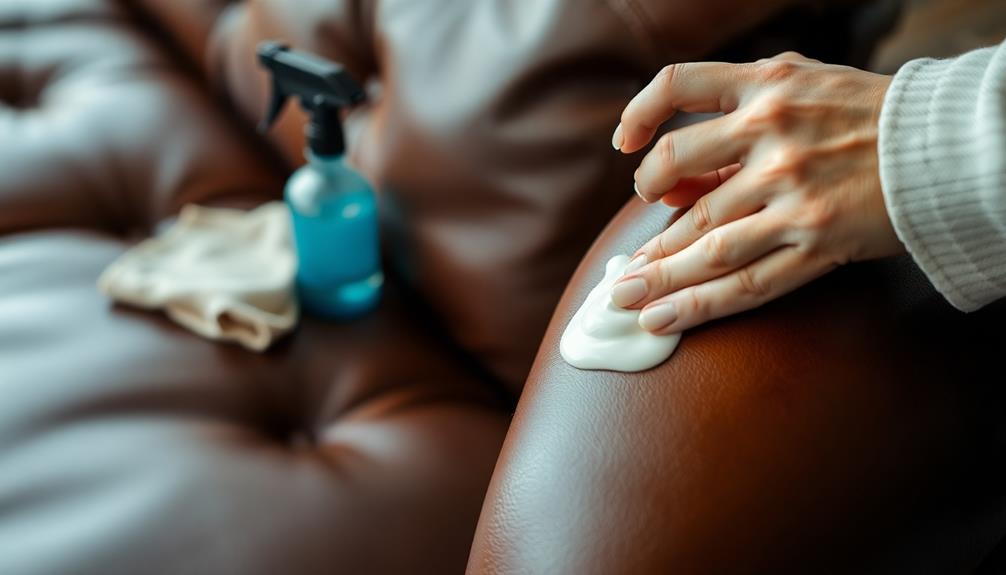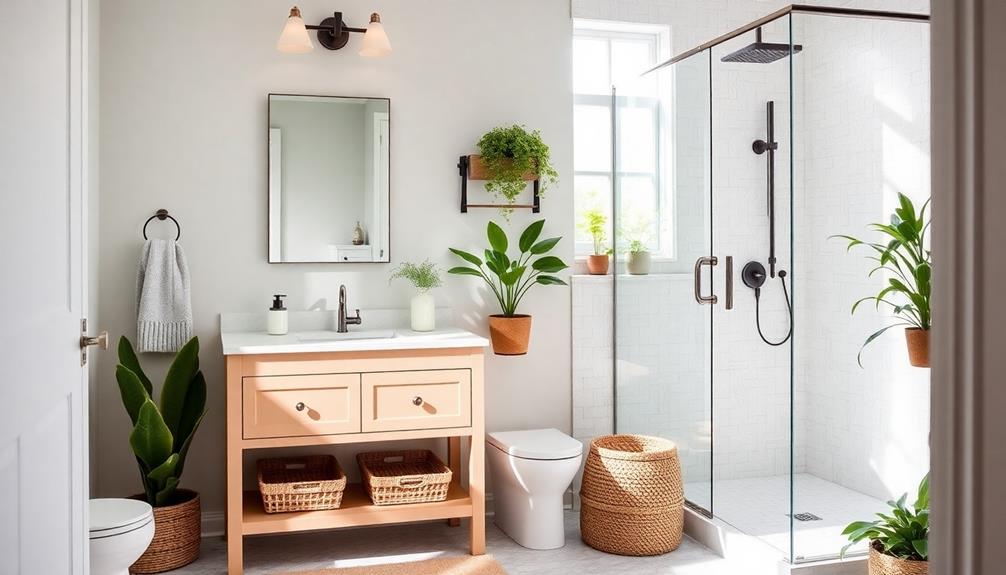You can easily firm up drooping leather on your sofa. Begin by cleaning the leather with a high-quality leather cleaner. Once it’s clean, apply a leather conditioner in circular motions to keep it supple. For reshaping, lightly spray the leather with distilled water and stretch it out as it dries. If you see significant sagging, think about using leather glue to provide extra support, securing it with clamps while it dries. Routine maintenance and care can also assist in preventing future problems. For more tips on maintaining your leather furniture in excellent condition, continue to explore the various options available.
Key Takeaways
- Clean the leather with a high-quality cleaner and a soft cloth to remove dirt before tightening.
- Apply leather conditioner in circular motions to maintain suppleness and prevent further sagging.
- Lightly mist the leather with distilled water and hold it taut while it dries for a snug fit.
- Use leather glue on sagging areas and secure them with clamps during the drying process.
- Consider professional assistance for extensive sagging or damage that home remedies cannot resolve.
Causes of Sagging Leather
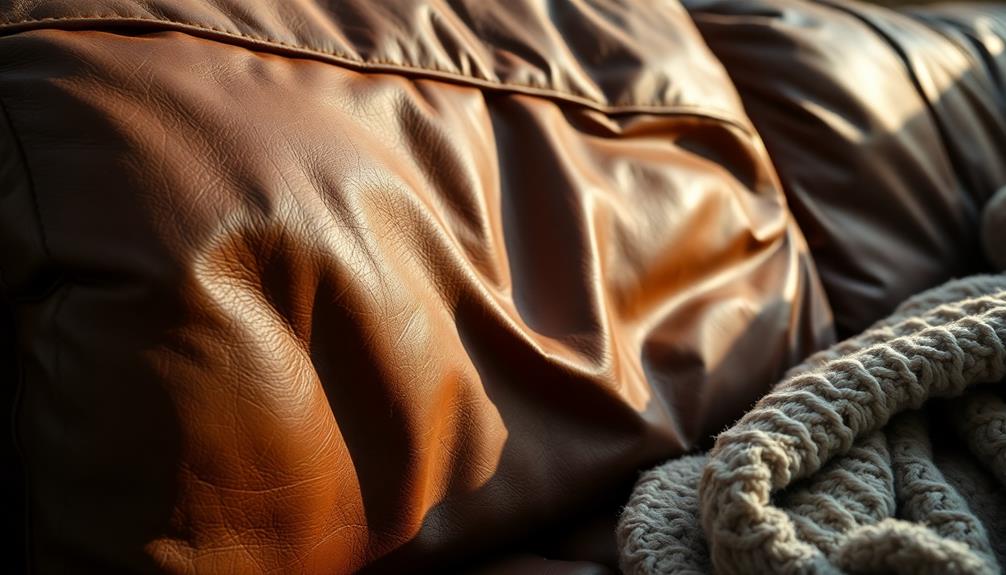
Leather sofas can sag over time, and understanding the causes can help you address the issue effectively. One major factor is the natural aging of high-quality leather. Even though it's durable, it deteriorates, leading to sagging leather. Continuous pressure and wear and tear from regular use stretch the leather, especially in areas that bear the most weight, like the seat cushions.
Additionally, environmental factors can worsen this issue, as crucial oils for leather care can help preserve and protect your sofa, preventing damage from humidity and heat.
Environmental factors also play a considerable role. Heat and humidity can cause your leather upholstery to expand and lose its shape, contributing to that sagging appearance.
Additionally, incorrect care can worsen the problem. If you use harsh chemicals or improper cleaning methods, the leather can become dry and cracked, further exacerbating sagging issues.
The construction of your sofa is another critical aspect. The quality of the leather and the type of frame and support materials can greatly influence its susceptibility to sagging.
To help maintain your sofa's appearance, it's vital to condition your leather regularly. This prevents dryness and preserves its integrity, which can mitigate sagging and keep your furniture looking its best.
Prevention Tips
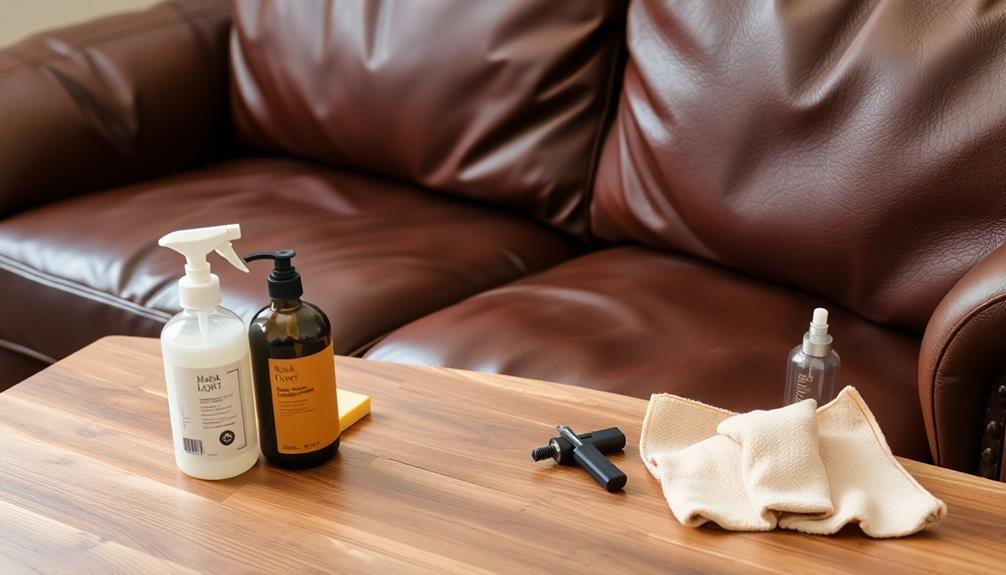
To keep your leather sofa looking its best, a few simple prevention tips can make a big difference. By taking proactive measures, you can maintain the integrity of your leather furniture and prevent sagging over time. Here are some key strategies to take into account:
- Avoid placing heavy objects on the cushions to prevent stretching. Additionally, regular cleaning and conditioning can help maintain its quality, similar to how well-draining soil is essential for healthy plants.
- Regularly clean and condition your leather furniture every 6-12 months using a quality leather conditioner to maintain suppleness and prevent drying.
- Protect your sofa from direct sunlight; UV exposure can lead to drying, cracking, and sagging.
- Rotate and fluff your cushions periodically to guarantee even wear and pressure distribution.
Additionally, keep humidity levels in your living space stable, as excessive moisture can cause leather to expand, leading to sagging.
Be mindful of heat sources that may dry out the leather, and always treat your sofa with care.
Following these prevention tips will help you enjoy a beautiful, taut leather sofa for years to come while preserving its quality and appearance.
Materials Needed
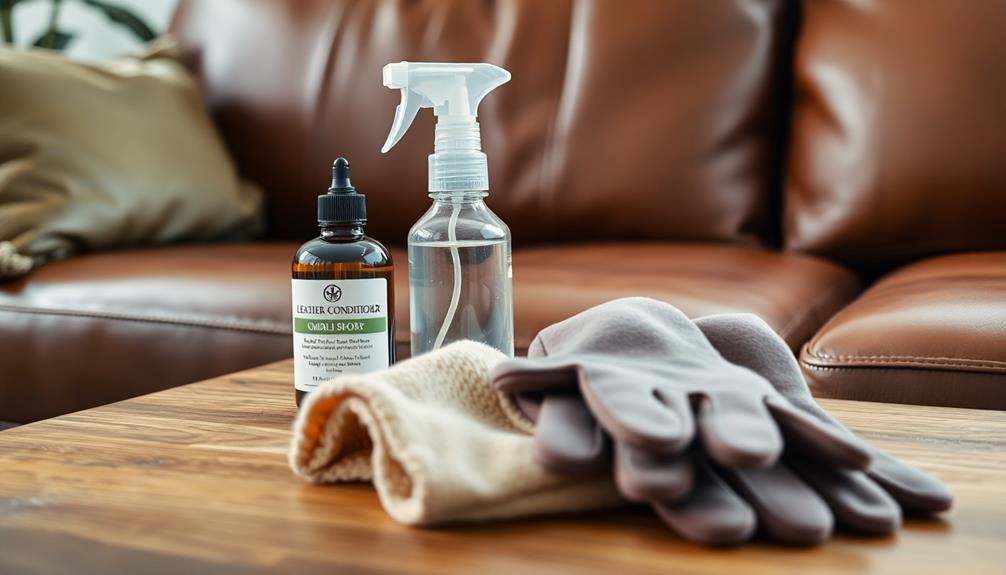
Before you get started with tightening your leather sofa, it's vital to gather a few key materials. Having the right tools will make the process smoother and more effective. Here's a quick list to help you prepare:
| Material | Purpose |
|---|---|
| Leather Cleaner | Remove dirt and oils from the leather surface. |
| Leather Conditioner | Restore moisture and flexibility to the leather. |
| Water Spray Bottle | Lightly dampen the leather for better tightening. |
| Rubber Gloves | Protect your hands while working with leather. |
| Cloths or Sponges | Smooth out wrinkles and hold leather in place. |
You'll want to start with a high-quality leather cleaner to guarantee the surface is clean before you begin. After cleaning, use a leather conditioner to keep the leather supple and flexible. The water spray bottle will help you dampen the leather without soaking it, which is vital for pulling it taut. Remember to wear rubber gloves to protect your hands during this process. Finally, have cloths or sponges ready for smoothing and securing the leather as it dries.
Step-by-Step Guide
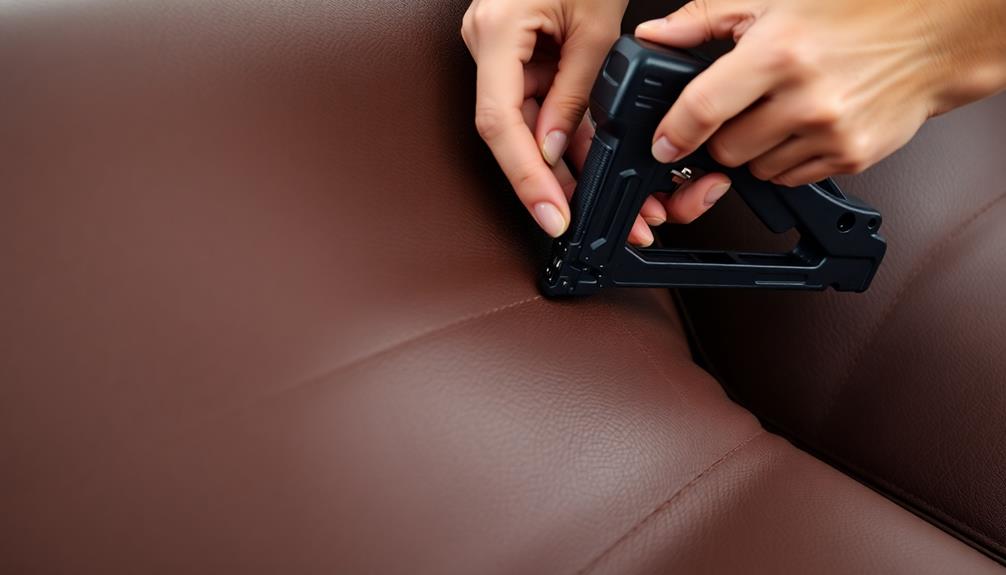
Now that you've gathered all the necessary materials, it's time to tighten your leather sofa effectively. Follow these steps to achieve a snug fit and restore its look. Regular maintenance, much like with appliances, can extend the lifespan of your furniture, ensuring it remains comfortable and visually appealing. Additionally, consider using energy-efficient appliances to complement your home decor while being mindful of energy consumption.
- Use a high-quality leather cleaner for effective cleaning.
- Apply a leather conditioner to keep the leather supple.
- Lightly mist with distilled water to reshape the material.
- Hold the leather taut while it dries for best results.
Start by cleaning the leather with a high-quality leather cleaner and a soft cloth to remove dirt and oils that could hinder the tightening process.
Next, apply a leather conditioner in circular motions; allow it to soak in for at least 15 minutes. Lightly mist the leather with distilled water to dampen it without saturating, which helps reshape the material.
Gently pull the leather taut, smoothing out any wrinkles while holding it in position. Let it dry naturally to maintain the tightness.
If you notice any sagging areas, use leather glue to secure them and consider clamps or straps to hold the leather in place as it dries completely. Your sofa will look refreshed and feel great!
Maintenance Practices
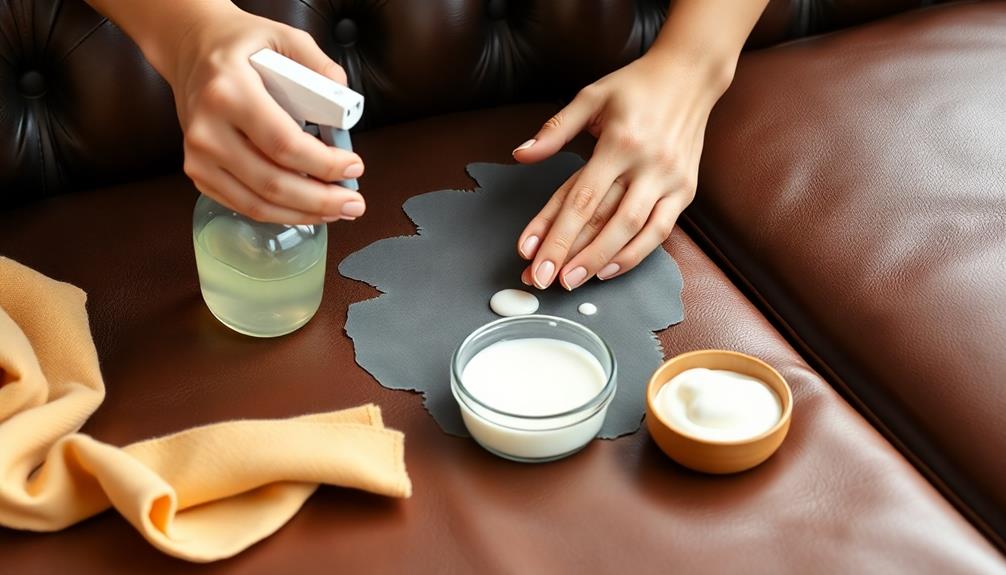
Maintaining your leather sofa is essential for preserving its beauty and longevity. To keep it in top shape, start by regularly cleaning it with a soft cloth and a high-quality leather cleaner. This prevents dirt accumulation that can contribute to sagging over time.
Every 6-12 months, apply a leather conditioner to maintain moisture and flexibility, ensuring the leather doesn't dry out or become brittle. Additionally, consider the significance of hydration and moisture in your environment, as dry air can also affect your leather furniture, similar to how hydration plays a role in gout management.
Another key maintenance practice is to rotate and fluff your cushions frequently. This helps distribute wear evenly and prevents sagging in commonly used areas.
It's also vital to keep your leather sofa away from direct sunlight and extreme humidity, as these conditions can damage and deform the leather.
Consider using protective covers on high-contact areas to minimize wear and prolong the lifespan of your leather furniture. In addition to reducing wear, protective covers can help shield your leather furniture from spills, stains, and fading caused by sunlight. To maintain a neat appearance and prevent constant adjustments, it’s important to use non-slip solutions or fasteners to keep sofa covers in place. This ensures your furniture stays protected while also offering a polished and tidy look to your living space. Additionally, it’s important to choose covers made from breathable, gentle fabrics to prevent any damage or scratching to the leather surface. Regularly adjusting and checking the fit will not only keep sofa covers on leather securely but also maintain an attractive and comfortable seating area. With the right approach, both the comfort and longevity of your furniture can be preserved effectively.
By incorporating these simple maintenance practices into your routine, you'll keep your leather sofa looking great and functioning well for years to come.
Common Problems
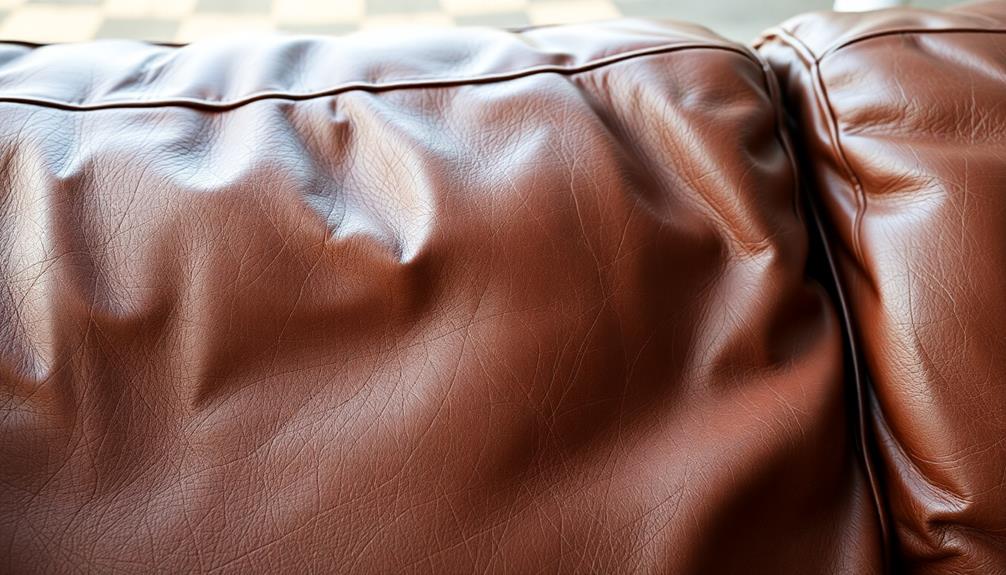
Even with proper maintenance, leather sofas can face several common problems that affect their appearance and comfort. You might notice these issues creeping in over time, especially if your sofa sees a lot of use. Here are some problems to watch out for:
- Sagging: Often caused by inadequate support from the seat cushions, leading to stretching and loss of shape. Additionally, environmental factors can exacerbate this issue, similar to how certain flooring types require specialized care, as seen with vacuums for LVP cleaning.
- Environmental Factors: High humidity and heat can deteriorate leather, causing it to sag and crease more easily.
- Indentations: Regular usage can lead to visible indentations and an uneven surface texture, particularly in frequently used areas.
- Poor Quality Materials: Sofas made with low-quality materials can exacerbate sagging issues, lacking the durability needed for long-term support.
If you notice signs of sagging, such as increased discomfort during use, visible wrinkles, and an uneven leather appearance, it's crucial to address these issues promptly.
Ignoring them can lead to further deterioration, making it harder to restore your leather sofa to its former glory. Staying vigilant can help you maintain its beauty and comfort for years to come.
Expert Advice
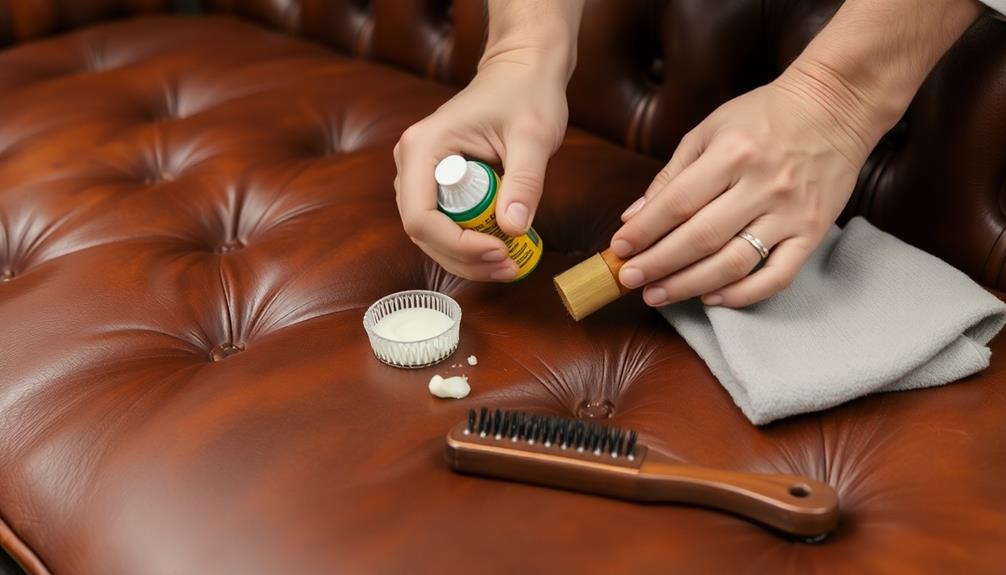
To keep your leather sofa looking its best, regular maintenance is essential. Cleaning and conditioning your expensive leather every 6-12 months helps maintain its suppleness and prevent sagging. Here's some expert advice to keep your leather in top shape:
| Technique | Steps to Follow | Frequency |
|---|---|---|
| Cleaning | Use a leather cleaner and soft cloth. | Every 6-12 months |
| Conditioning | Apply a quality leather conditioner evenly. | Every 6-12 months |
| Hot Towel Technique | Microwave damp cotton towels and apply to wrinkles. | As needed |
| Heat Application | Use a heat gun or steam iron on low settings. | When sagging occurs |
| Professional Help | Consult furniture retailers for extensive sagging. | When necessary |
Dampen the leather lightly with a spray before trying to tighten it; this makes it more pliable. Remember, caution is key when using heat—overheating can damage the leather. If sagging persists, it's best to seek professional advice. By following these tips, you can keep your leather sofa looking as good as new for years to come!
Frequently Asked Questions
Can You Fix a Sagging Leather Sofa?
Yes, you can fix a sagging leather sofa. Start by cleaning and conditioning the leather, then try dampening it and pulling it taut. For better results, consider using heat or consulting a professional for extensive sagging.
How Do You Tighten Loose Leather?
To tighten loose leather, clean it first, then lightly dampen it. Pull the leather taut, smoothing out wrinkles. Hold it in place while it dries, and finish with a conditioner to maintain its shape.
How Do You Restore Saggy Leather?
Think of saggy leather like a deflated balloon—it needs a little care. Start by cleaning it, then apply conditioner. Dampen it lightly, use heat to relax it, and let it regain its shape.
How to Fix a Wrinkled Leather Sofa?
To fix a wrinkled leather sofa, start by cleaning it. Lightly mist the wrinkles with distilled water, then gently warm the areas with a heat gun. Finally, massage the leather to smooth out the wrinkles.
Conclusion
By understanding the causes of sagging leather, you can take proactive steps to tighten your sofa and restore its elegance. With the right materials, a clear process, and consistent maintenance, you can keep your leather looking sharp and feeling firm. Remember, prevention is key, and regular care guarantees longevity. So, tighten today, maintain tomorrow, and enjoy your sofa for years to come. A well-cared-for sofa not only enhances your space but also elevates your comfort.
